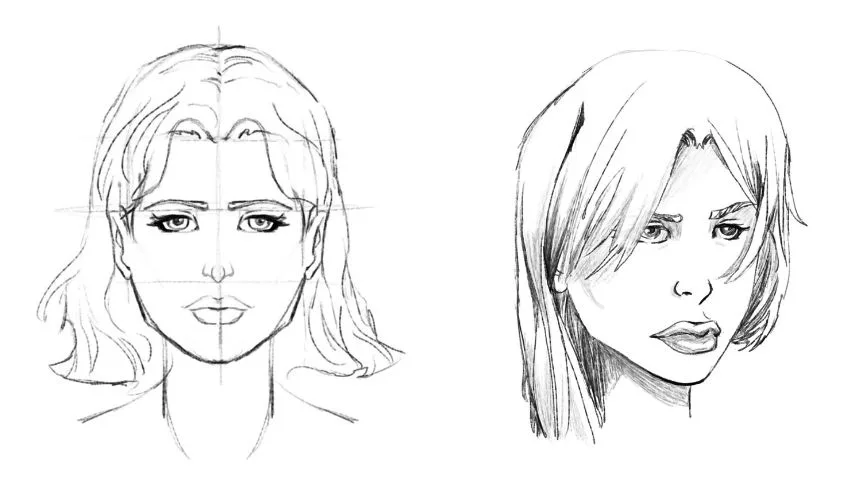Learning how to draw a face like a pro can be done in the following two approaches covered in this article.
In the frontal view, we take a more straightforward, more geometric approach to the subject matter, and in the three-quarter turn, we look at a more organic yet still structured method.
Finally, we’ll take a look at different ways to make a face more masculine and feminine.
Proportion and location are essential in the initial stages of learning to draw faces like a pro.
After that, detail and the intricate shapes of different features are crucial. So without further ado, let’s get started with this step by step tutorial.
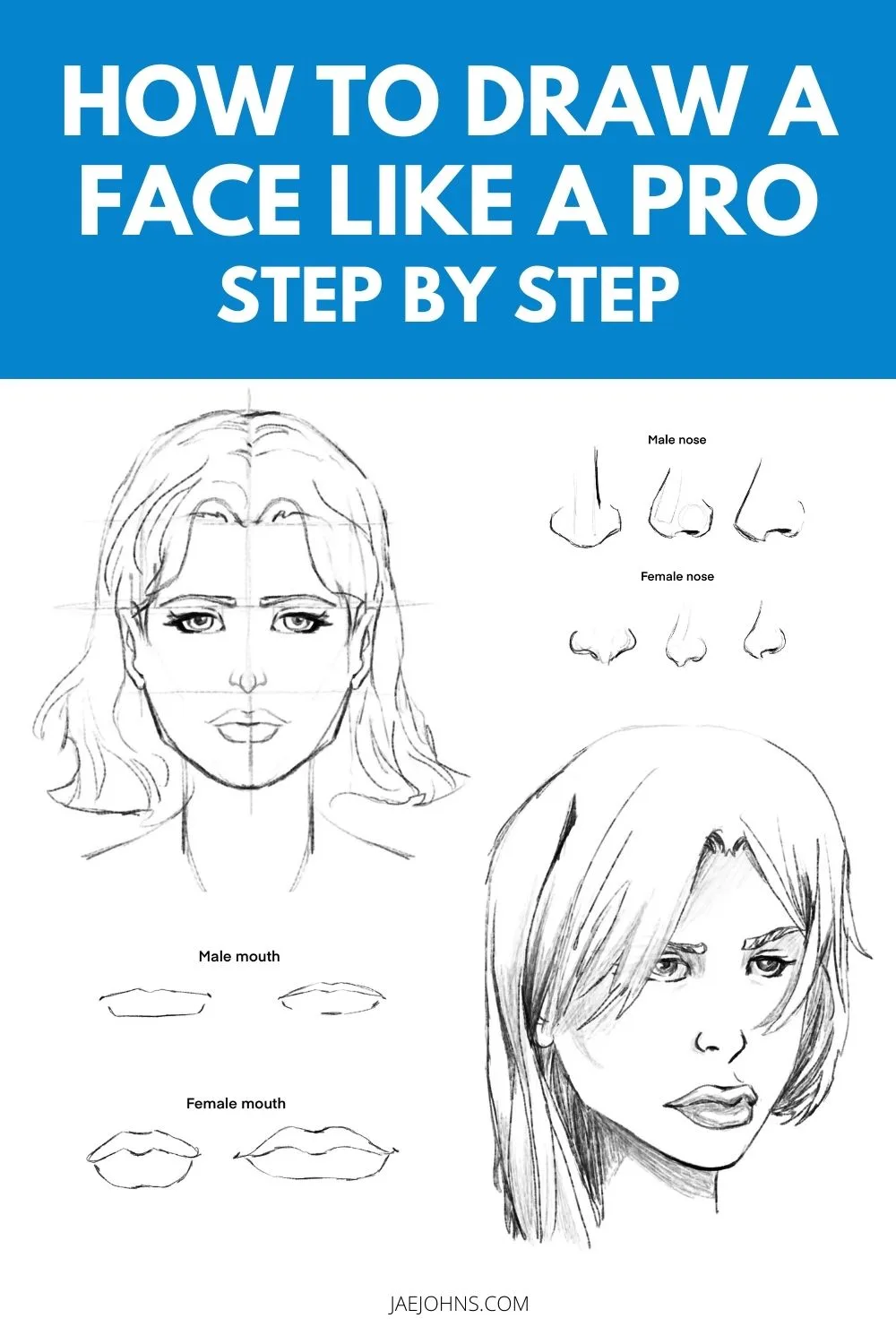
How to Draw a Face from the Front – Step by Step Instructions
When learning how to draw a face you want to begin with any type of paper, you can use a 4B pencil, mechanical pencil, or any other kind of professional drawing pencil of your choice.
Following this series of steps, you’ll be able to draw a face from the front.
Step 1 – Draw an Oval
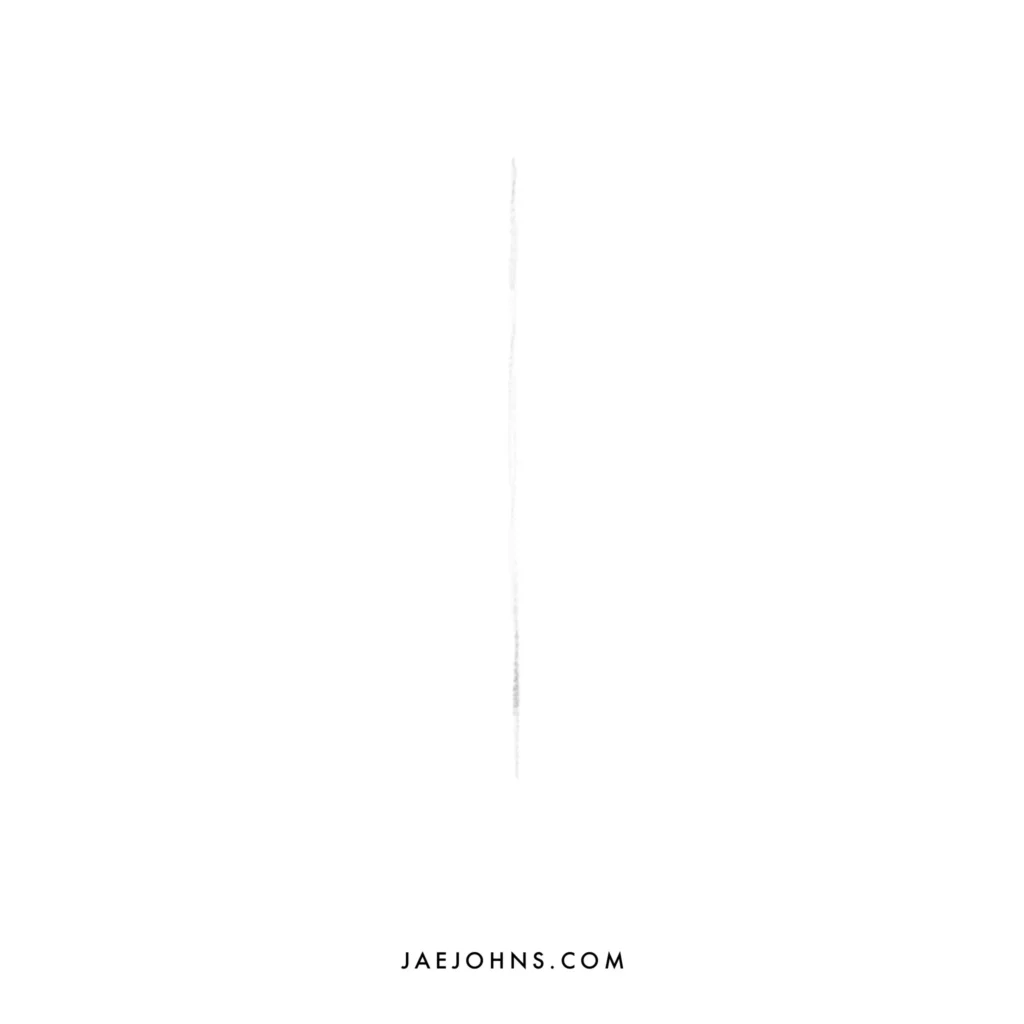
First, draw a vertical centerline that will form the symmetrical center of the face.
The front view has to be quite precise to work well on the piece of paper.
Drawing a head from imagination is quite difficult, especially from this view, and so it is important to focus on the proper facial proportions.
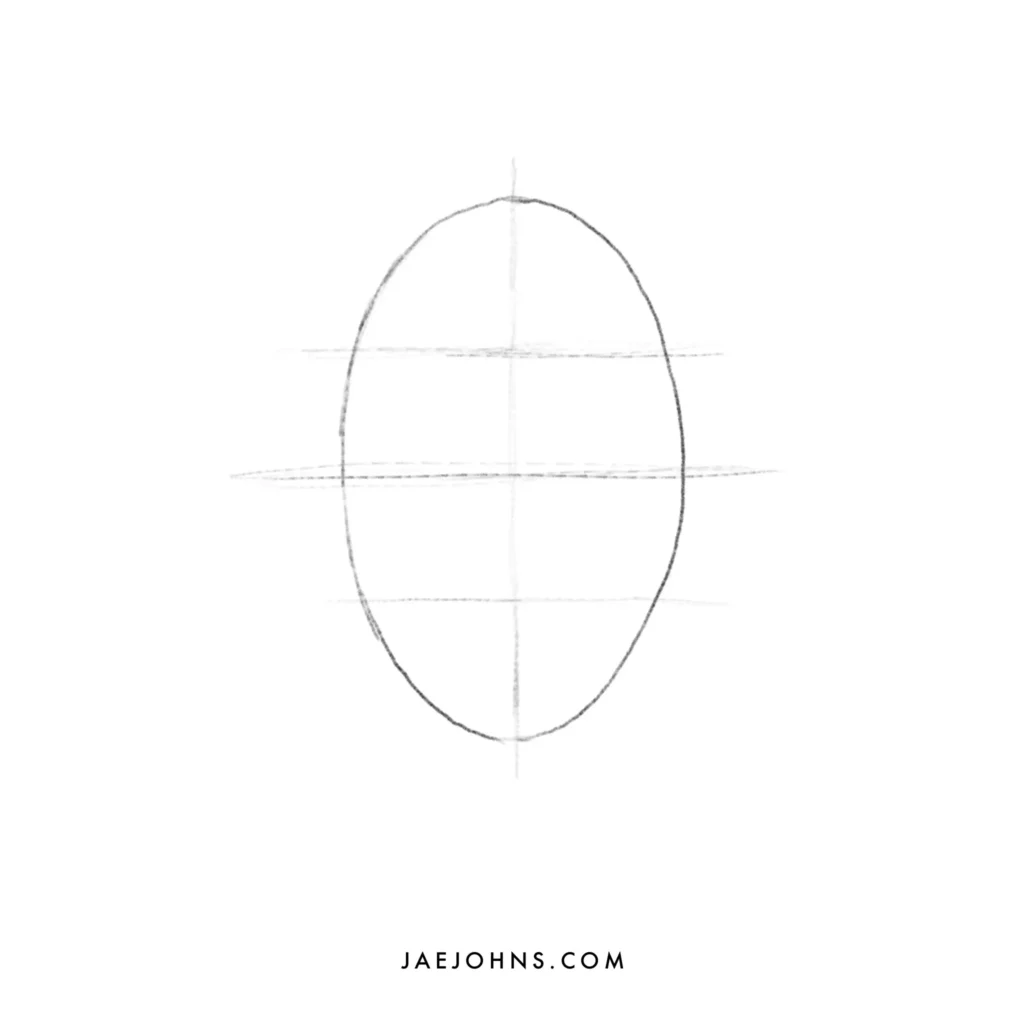
Then, draw an oval face shape over the centerline.
You’re now going to split the face into four equal-sized parts with horizontal lines forming exact guidelines for accurate proportions of the face.
The first line from the top is the hairline on the forehead.
The middle line will form the browline, and the third line will be the bottom of the nose.
Step 2 – Draw Sidelines for Guidance
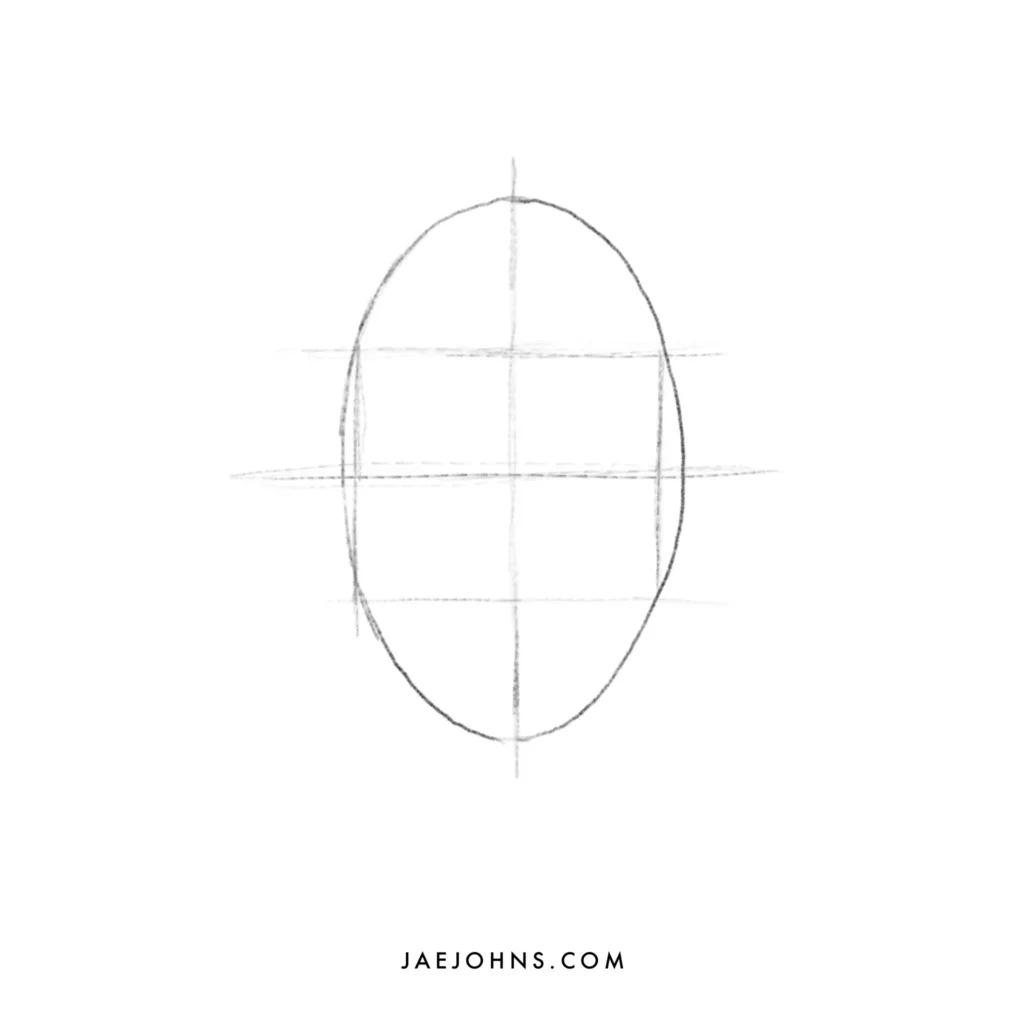
You should now be able to complete a rectangular shape from the horizontal lines within the oval.
The top line is the hairline and the nose line is the bottom line.
You can now draw the side edges of the rectangle as guidelines that will represent the edges of the face.
Remember to use lighter pencil strokes for these initial stages as they are being used as basic guidelines and not the real lines of the portrait.
Soft pencils work well for this stage.
Step 3 – Drawing the Facial Structure
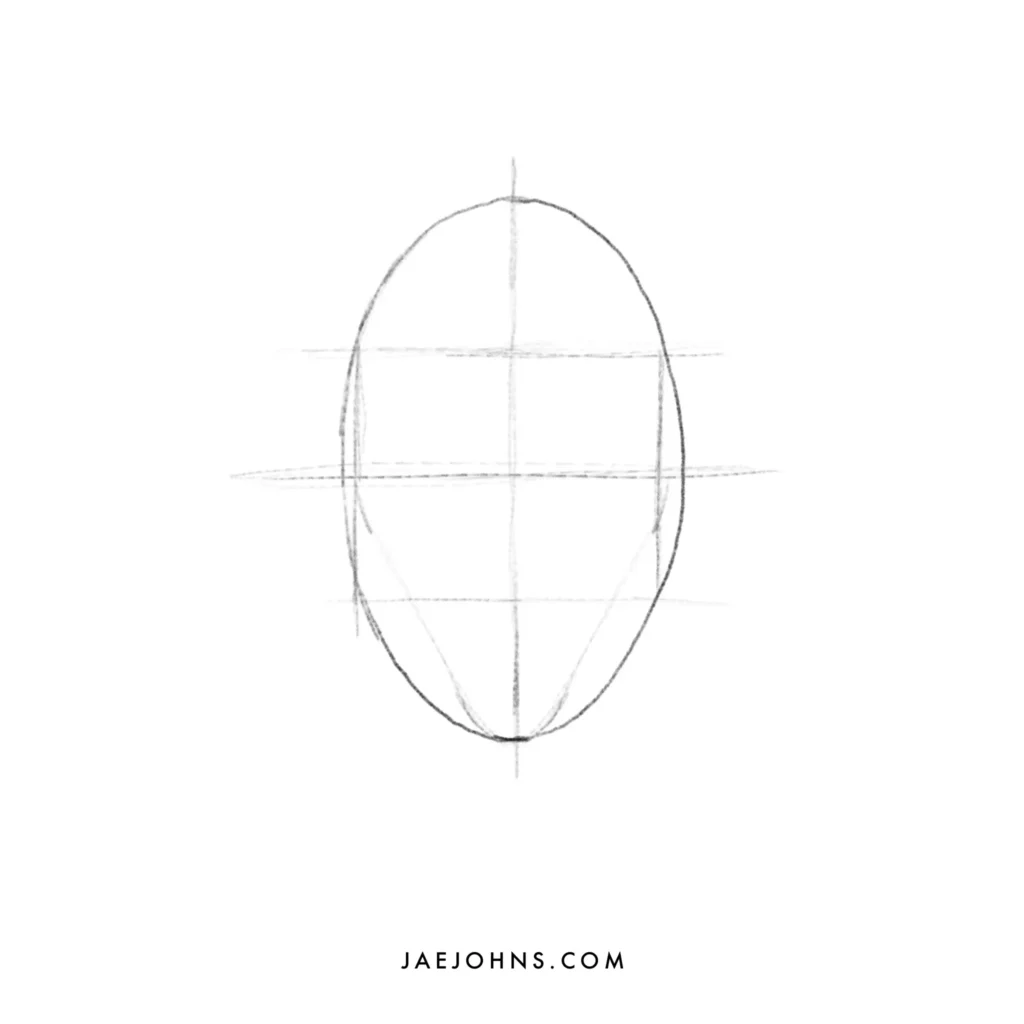
Using the guidelines you now have, you can carve out the bottom half of the face by defining the cheeks and jawbone in the bottom quadrant.
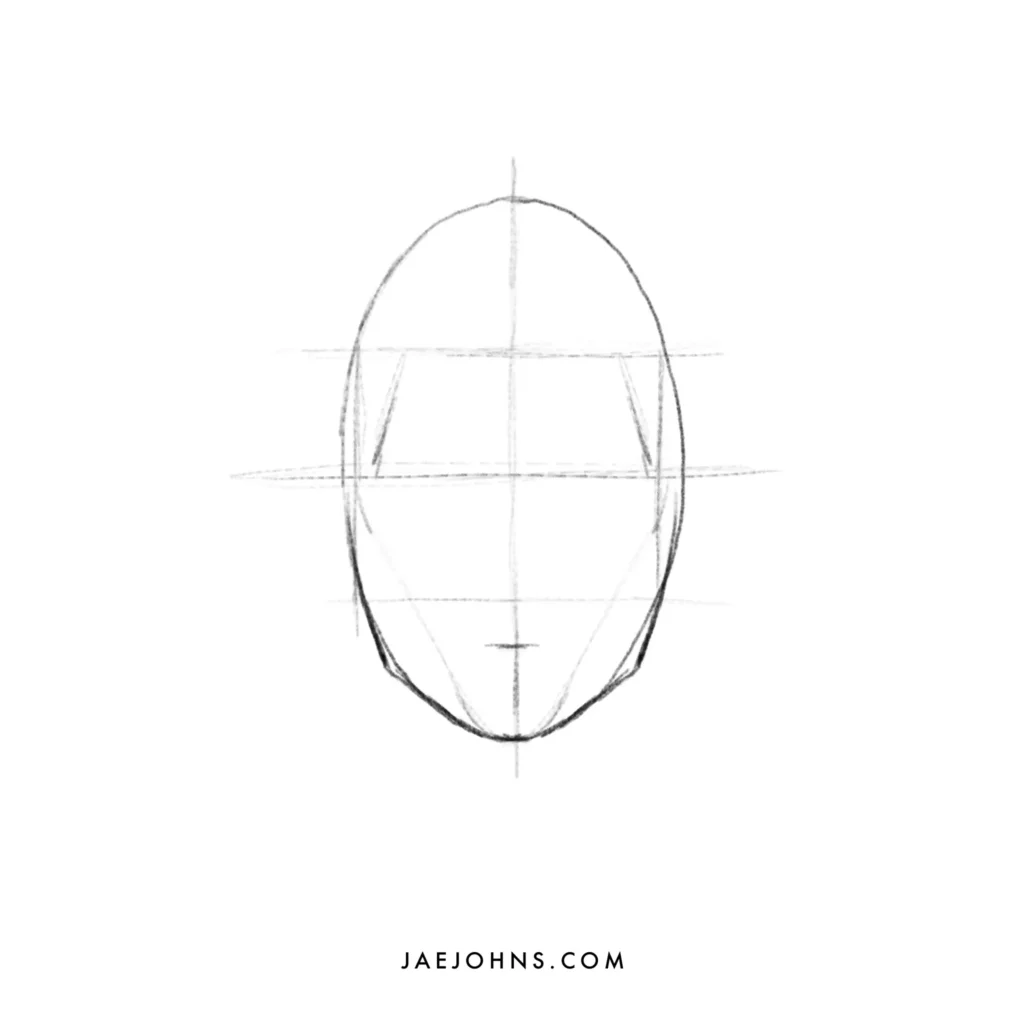
By measuring another horizontal guideline exactly halfway between the nose line and the very bottom of the chin, you’ll have a line for the jawline, with the mouth being placed just above it.
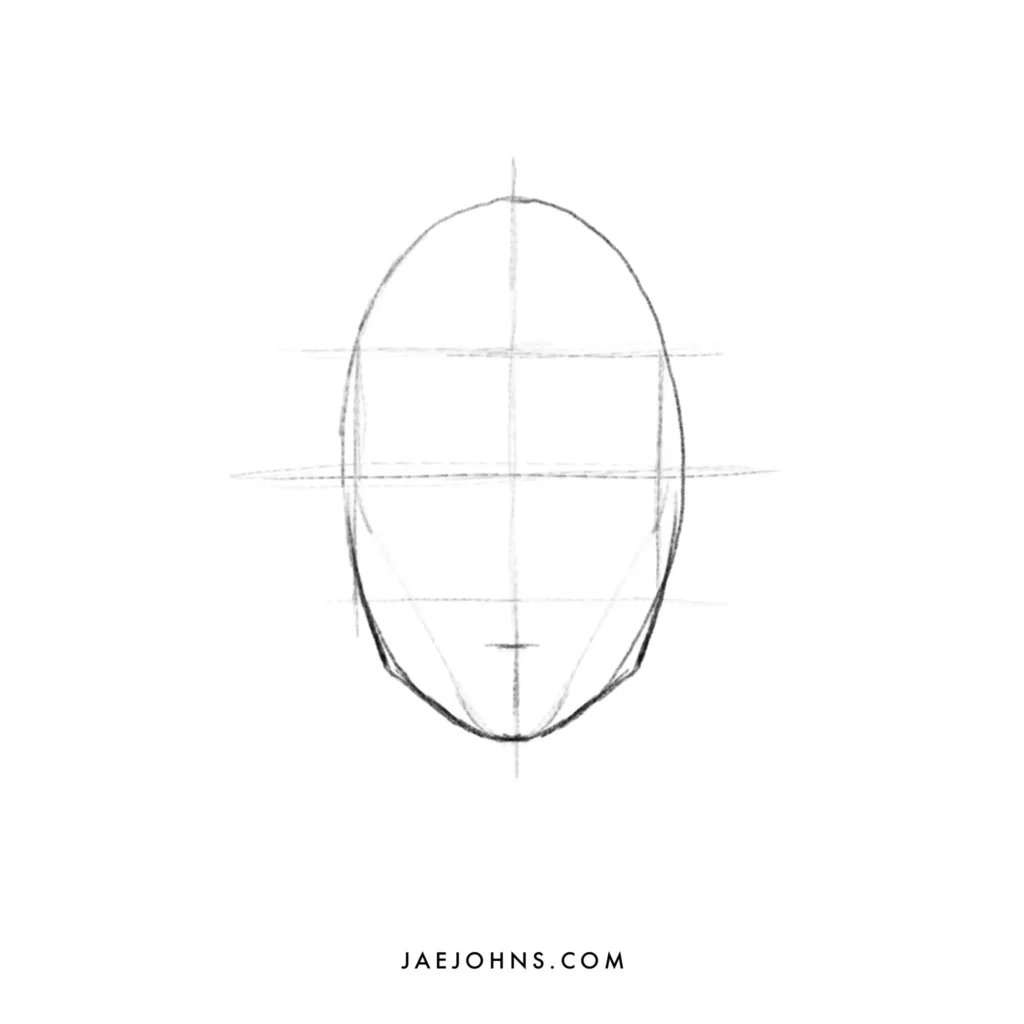
The forehead can also be drawn in slightly, as another line coming in slightly inward from the temples, giving the illusion of form.
Keep checking for symmetry as you go because the frontal view requires a lot of precision.
You can check with a mirror whether the symmetry is still working.
Step 4 – Draw the Ears
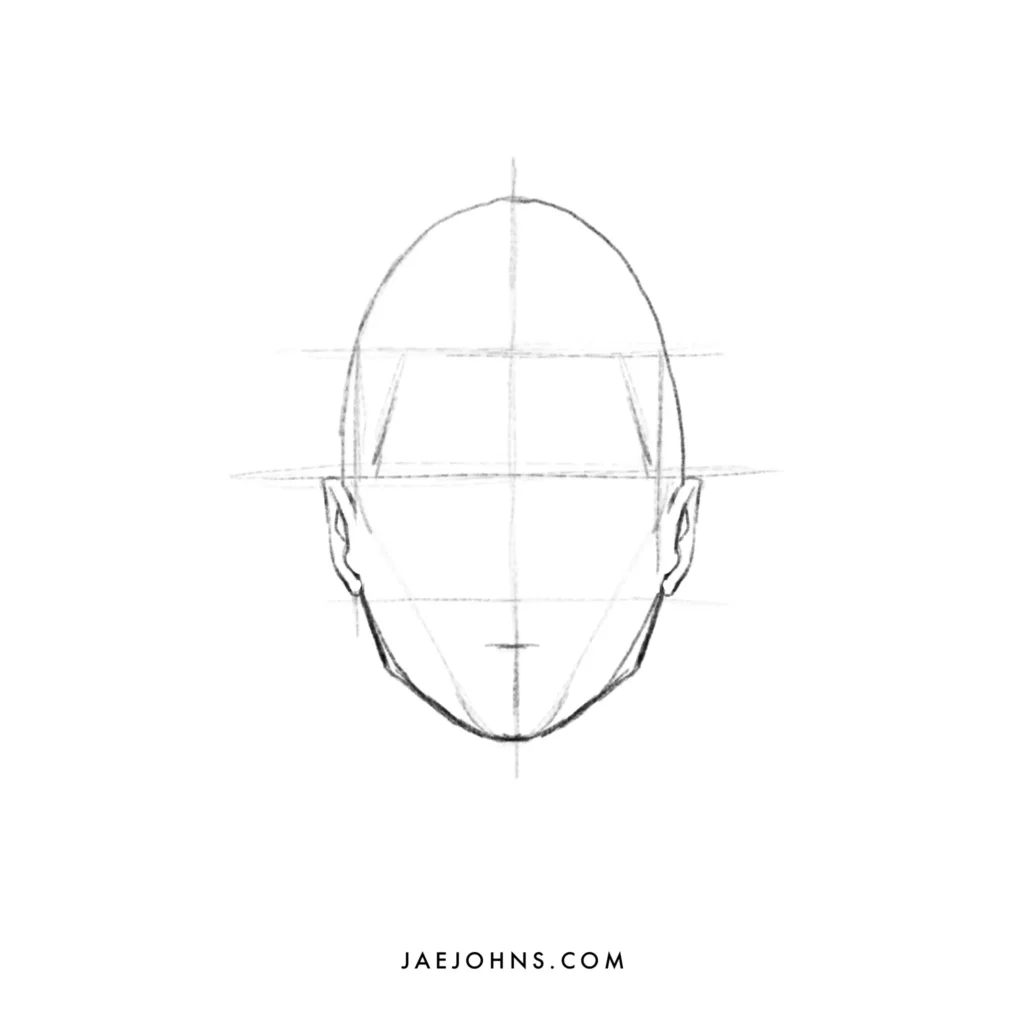
The top of the ears should match with the brow line, where the brow bone would be, while the bottom of the ears should match with the bottom of the nose line.
The ears should extend outward further the higher up they go.
However, depending on the type of ear, the amount they extend outward can change.
Step 5 – Find the Eyes
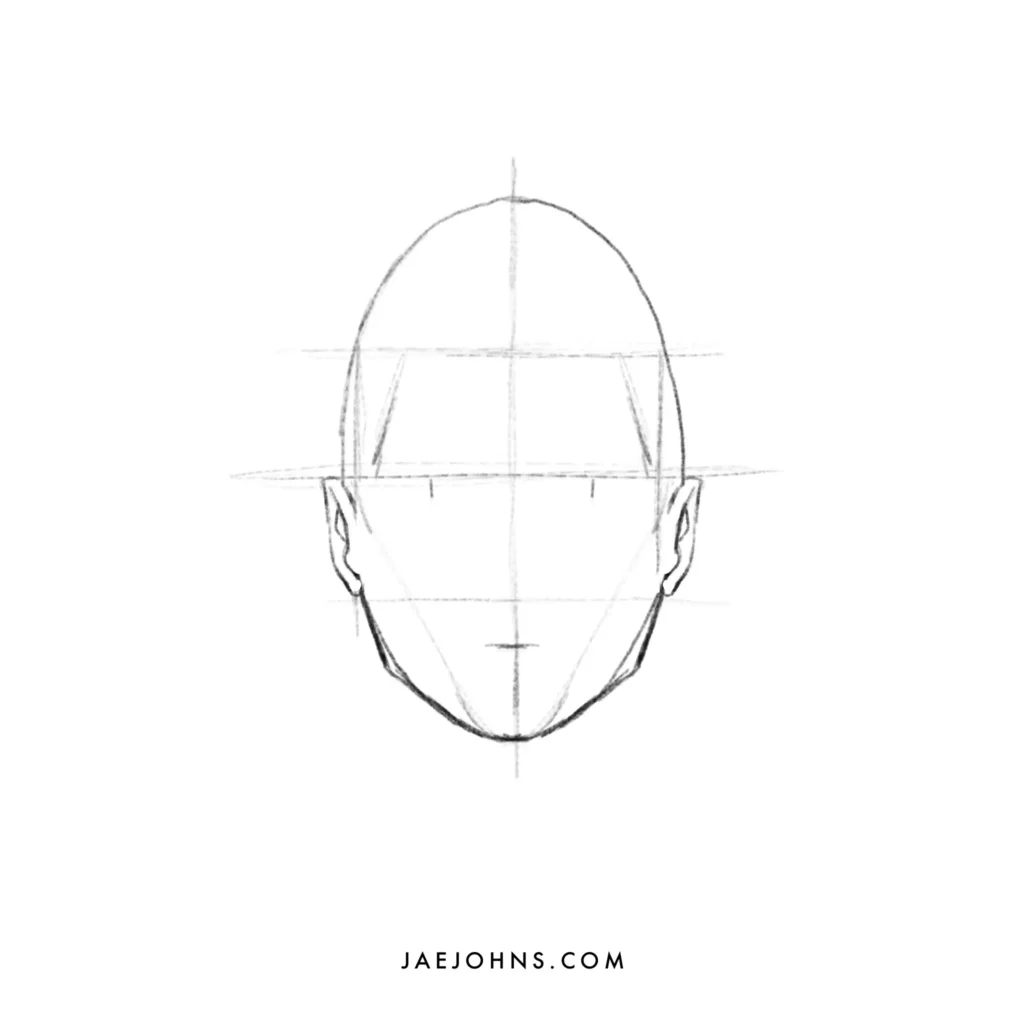
We now have the basic facial structure completed.
Next, it’s time to begin filling in the features.
We’ll first locate the eyes in the face.
Horizontally, the eyes are generally found just below the centerline of the face, making the centerline the brow line.
Vertically, you can make two new guidelines exactly halfway between the vertical centerline and each side of the face.
These will locate the center of the eyes.
Once you’ve found the proper location, the middle of the eyes should be placed just below the browline.
Step 6 – Draw the Eyes

Now that we’ve found the location of the eyes, we can draw them at the marked location.
For getting the width of the eyes, the measure from ear to ear should be split into five eye lengths, the 2nd and 4th of which is where you can place the eyes.
Each ear will be accounted for within the oval, so the five eye lengths should be measured to the oval’s inner edge.
The eyes are almond geometric shapes, and the pupils are a circle.
The outer edge of the eye slants in toward the nose.
Step 7 – Draw the Nose
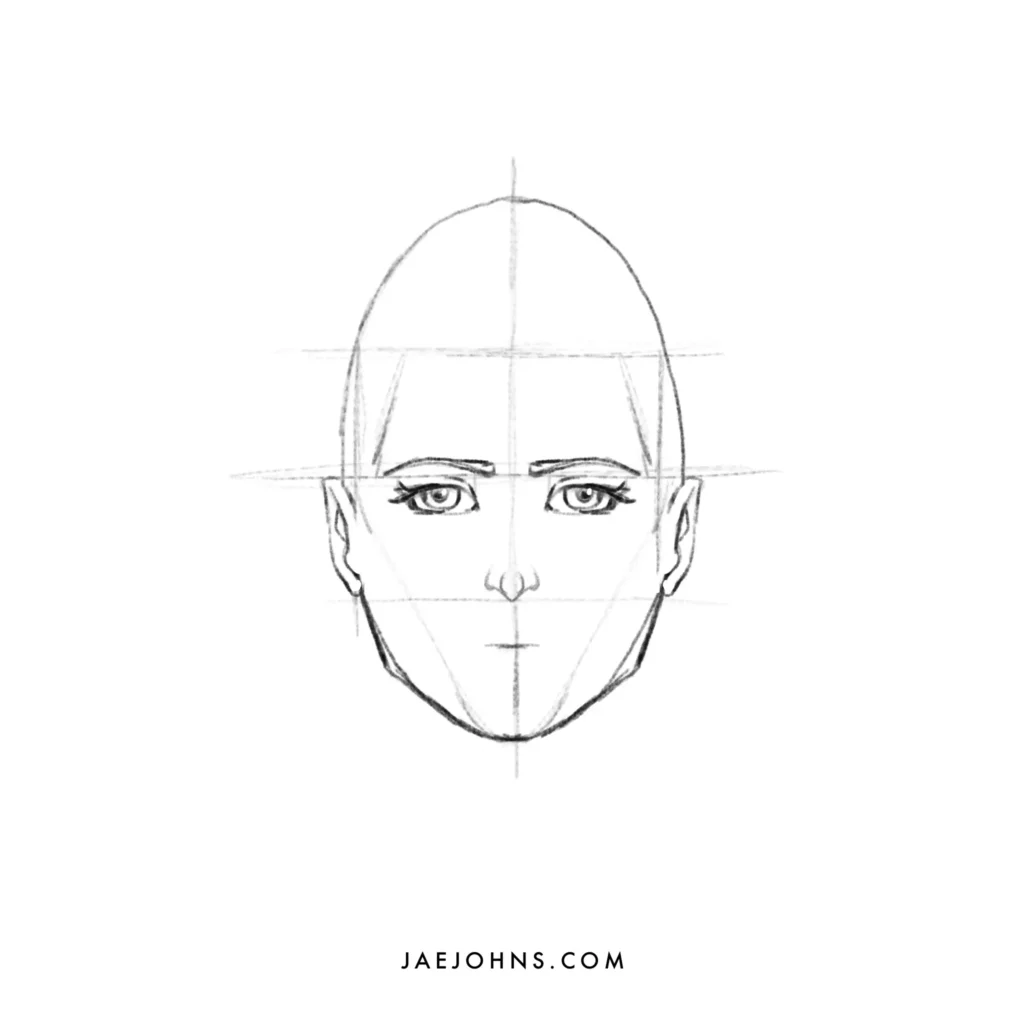
The bottom of the nose is found at the bottom line of the ear.
The region that defines the nose length runs from the bottom tip up to the eyebrows.
Noses can vary in length but are predetermined by the proportions of the eyes and mouth.
Sketch out the base of the nose and a nostril on each side.
The width of the nose varies widely depending on the person.
The average nose might be between the corners of the eyes (thereby taking up the width of the center eye measurement).
Some artists draw guidelines down from the corners of the eyes to get this width right.
You can look at a nose tutorial for more detailed instructions.
Step 8 – Draw the Mouth
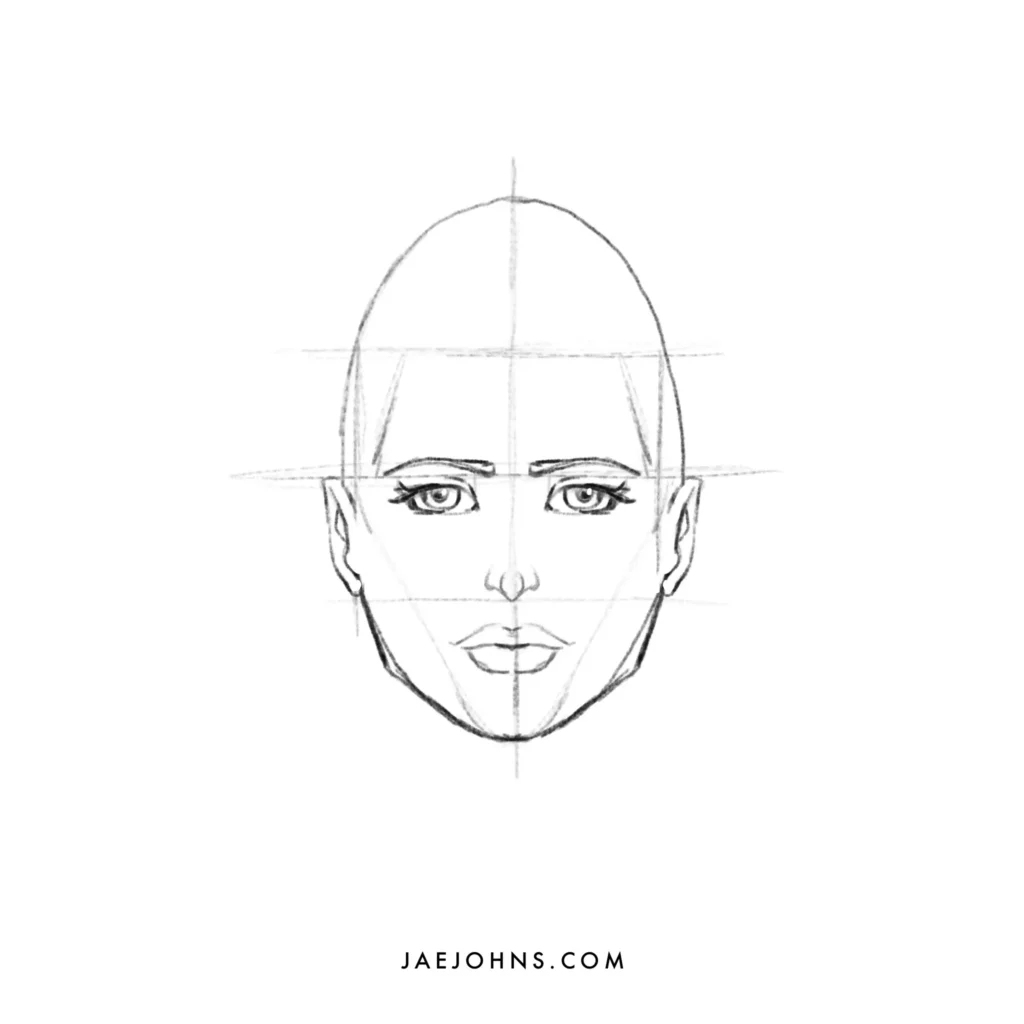
The mouth is generally a bit above the halfway distance between the bottom of the nose and the chin line.
A realistic mouth is another highly variable feature.
Leave a space between the top lips and the bottom of the nose.
The corners of the mouth should line up with the center of each eye.
Therefore, once you sketch in the pupils, you can use these are guidelines to draw the edges of the mouth.
Step 9 – Draw the Hairline
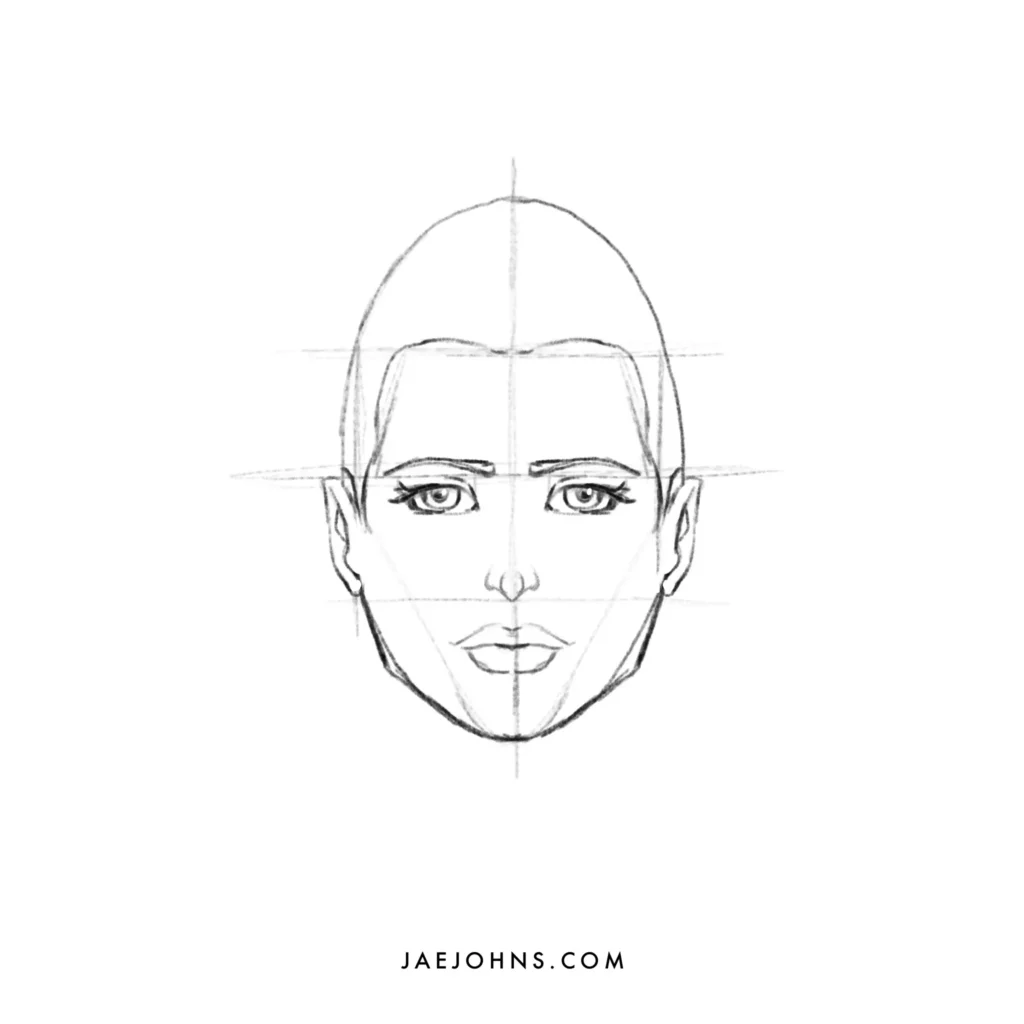
It’s important to know where the hairline begins regardless of whether some of the hair will be covering their forehead.
The hairline is the top edge of the square we drew at the start.
But, hairlines vary greatly depending on age, gender, and other factors.
Step 10 – Draw the Hair

For shorter hair, the hair should stick straight up from the skin.
The hair may begin to fall slightly from the top for slightly longer, and different hairstyles will have different patterns.
Never draw the hair directly on the scalp, but allow it to extend outwards from the scalp with its length.
Step 11 – Draw the Neck
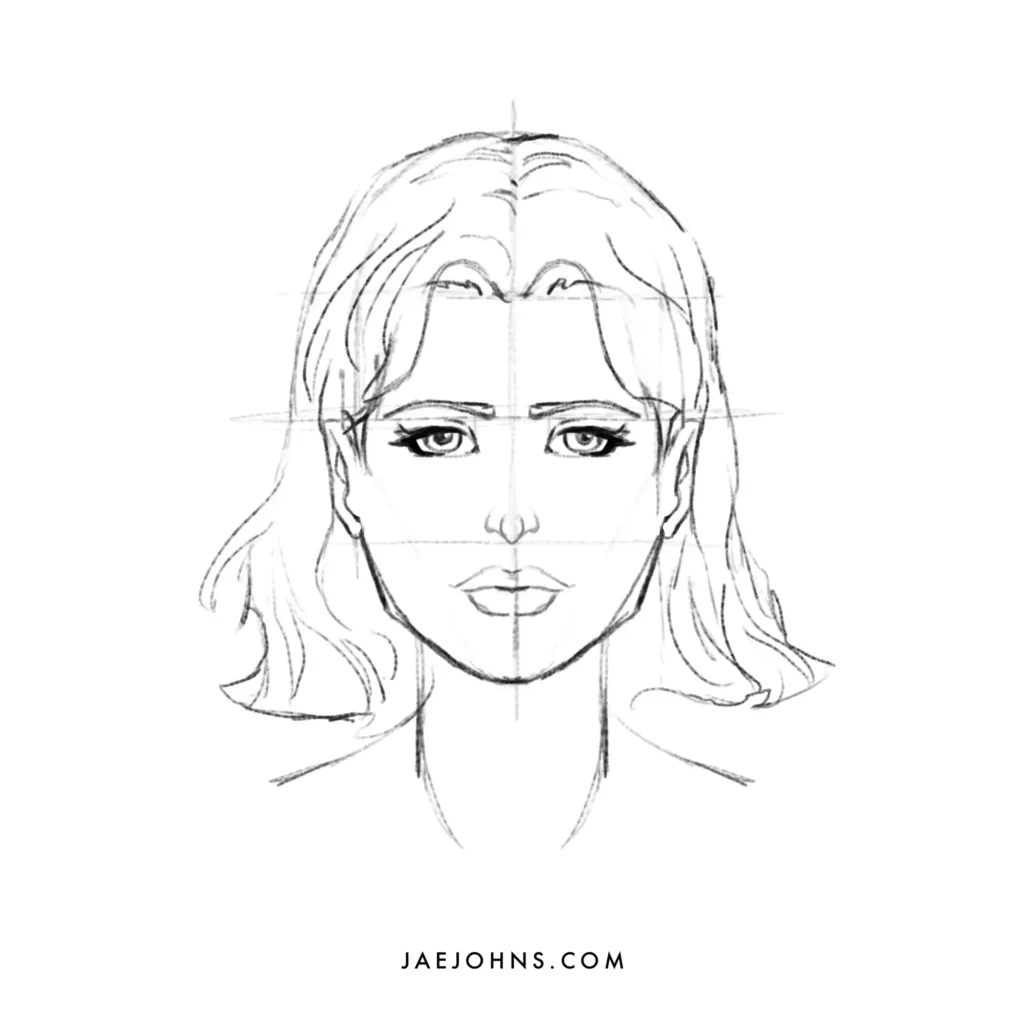
To finish up our floating head, we’ll need to add in the neck.
Unfortunately, most artists tend to draw the neck too narrow for realistic proportions.
Generally, the neck begins from the bottom of each ear, although womans’ necks are more slender.
Read Also:
How to Draw a Face from a Three-Quarter View
Knowing how to draw a face from three-quarter view is easy with the following step-by-step tutorial.
This should give you a good idea of who to begin considering the shape and proportions of the face from different angles.
Premium acid-free paper works well for this kind of drawing.
Step 1 – Draw the Face Structure
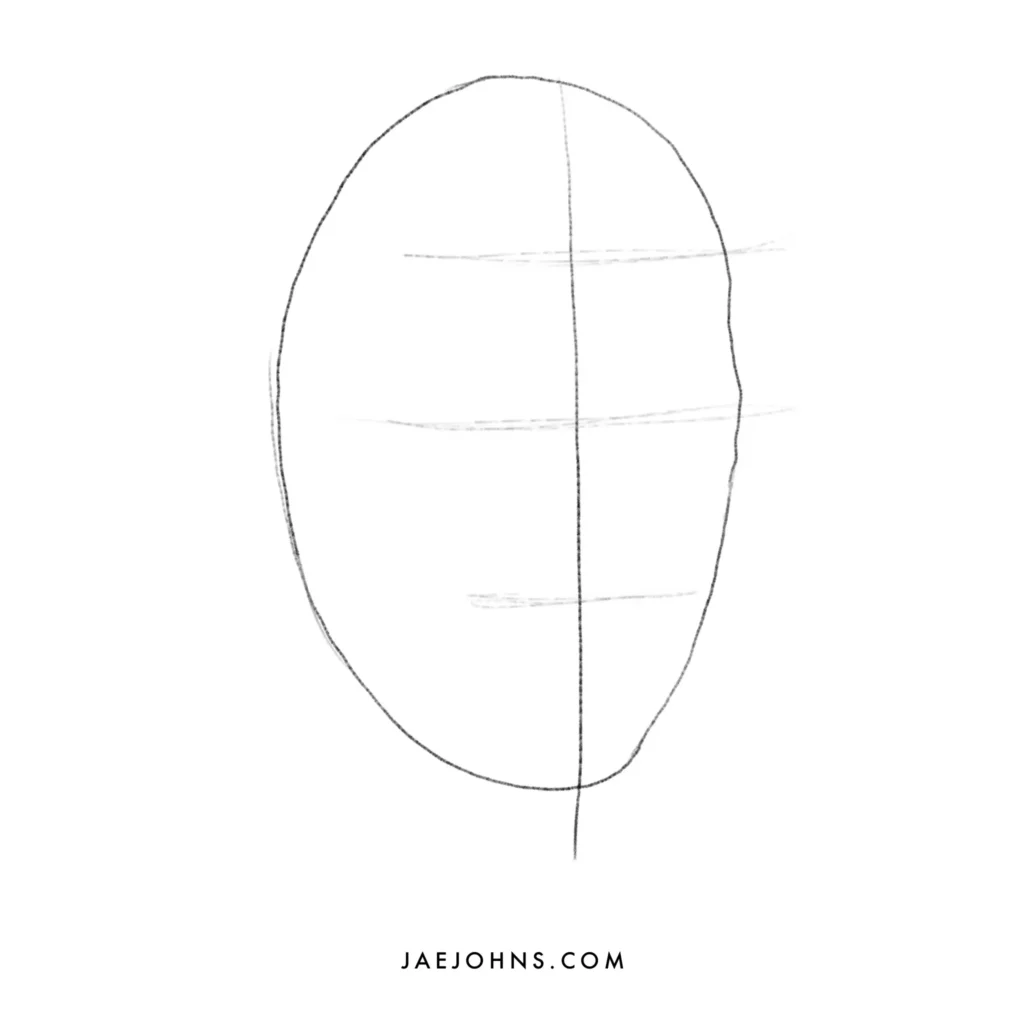
We’ll be using a different technique to do a portrait of your subject from a three-quarter turn.
This step-by-step approach should expand your view of different ways to see a face in a drawing.
Begin by drawing an oval shape for the face.
Once you have the oval shape, you’ll be drawing the vertical line slightly to the right of the center.
Then, place one horizontal line through the center, and one in the midway point between the top and the midline, and another from the bottom and the midline.
This should split the face into four equal parts.
Each part indicates one of where the nose, eyebrows, and hairline will go.
Step 2 – Locating the Hairline, Mouth, and Ears
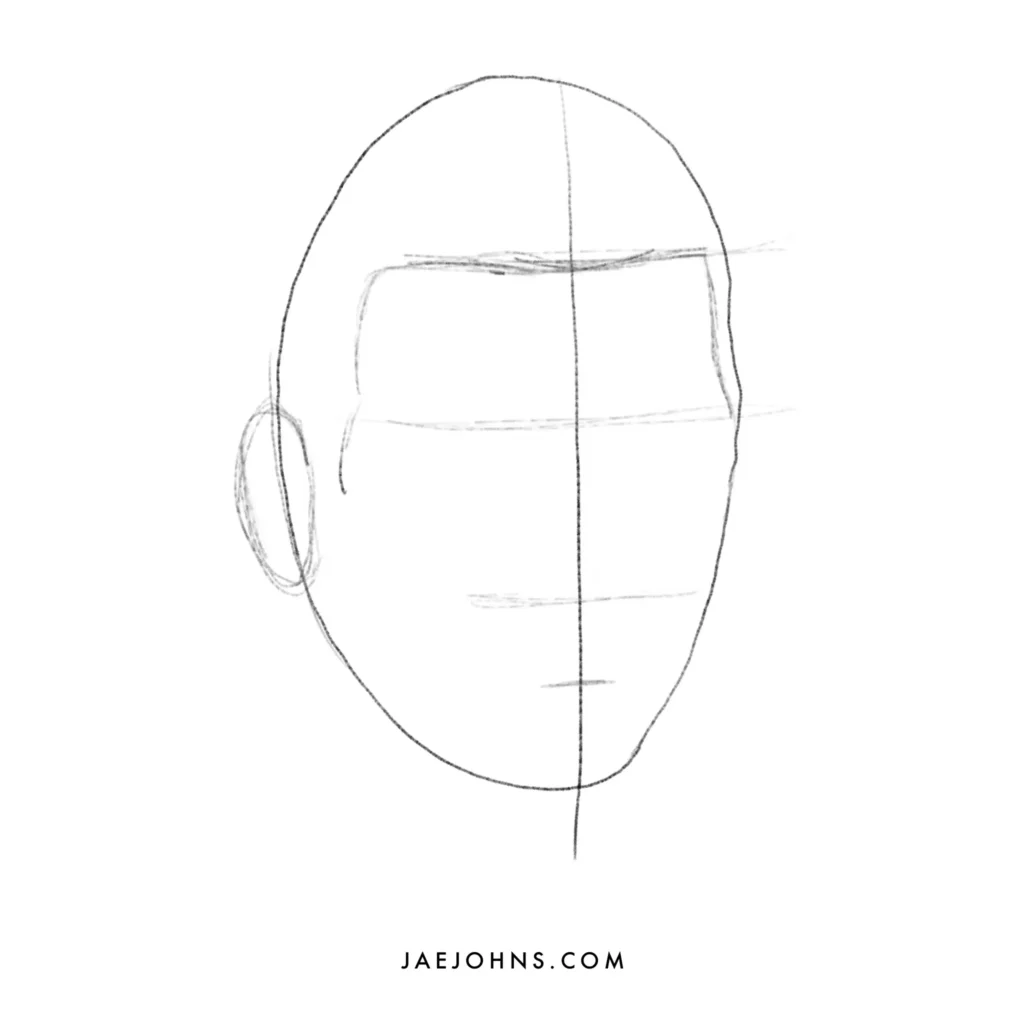
The horizontal lines now act as markers for the hairline, mouth, and ears.
For example, sketch the hairline from the top line curving down to behind the ears, which is just below the middle line.
For mouth position, draw a line about a quarter of the way down between the bottom line and the chin.
The bottom line will act as the bottom of the nose, while this new line will be the middle of the mouth.
Draw the ears with the top of the ear just touching the middle line and the bottom of the ear beginning just a quarter of the way up from the bottom line.
Step 3 – Draw the Eyebrows, Eyes, Lips, and Nose
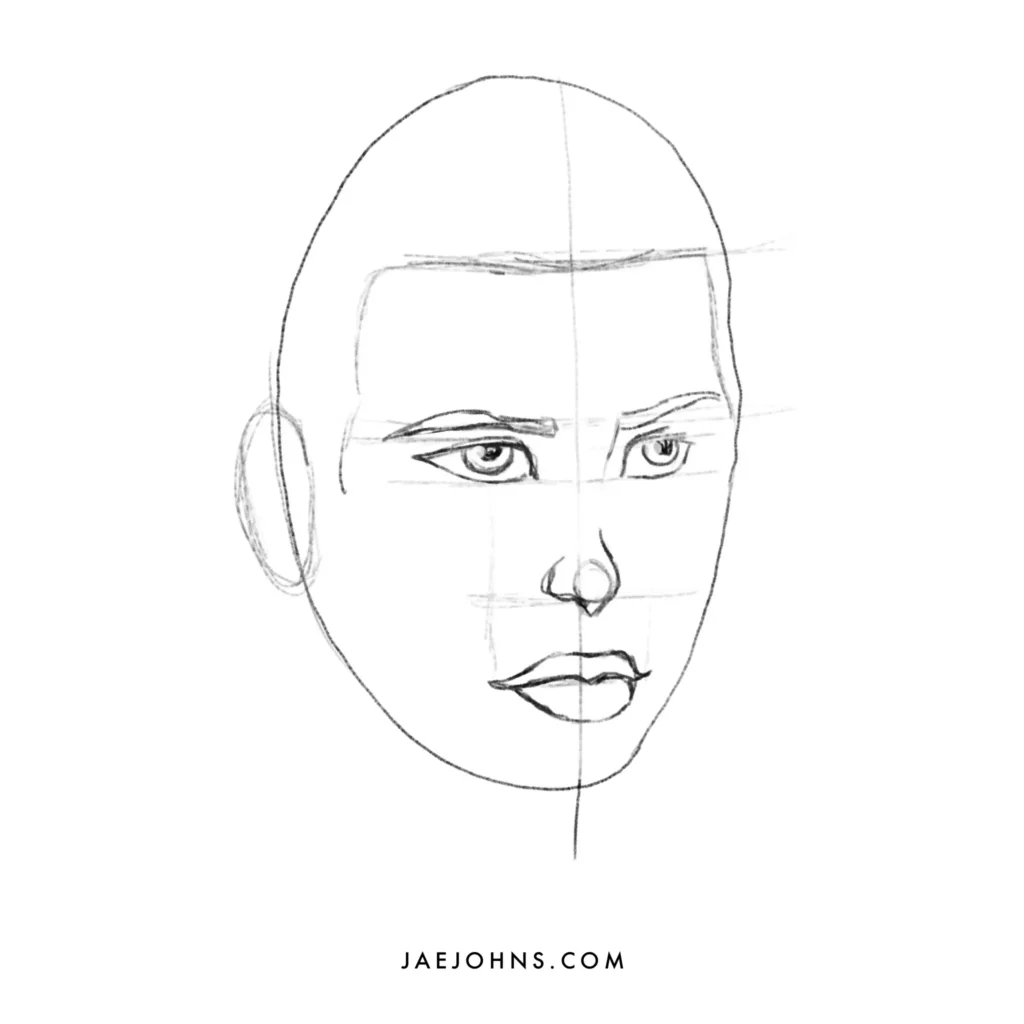
The eyebrows should be drawn with the bottom tip balanced on the second line.
It can be a tricky subject, but the eyebrow angles can help determine the overall shape of the face.
For a proportionate nose, draw the bottom tip and nostrils to line up with the bottom of the earlobe just above the centerline.
Then, to draw the lips, use the mouth line created above as the part between the top and bottom lips.
There should be a small space between the top lip and the nose.
For the eyes, draw three lines across the centerline to make the highest and lowest points of the eye and for the outside corners.
The very edge of each nostril should line up vertically with the edge of the inner corner of the eye.
The pupil should lie at the center of the eye for a neutral position, but depending on the angle can be placed a little to the left or the right to line up as the person looks forward.
Step 4 – Erase the Guidelines, Fill in the Details
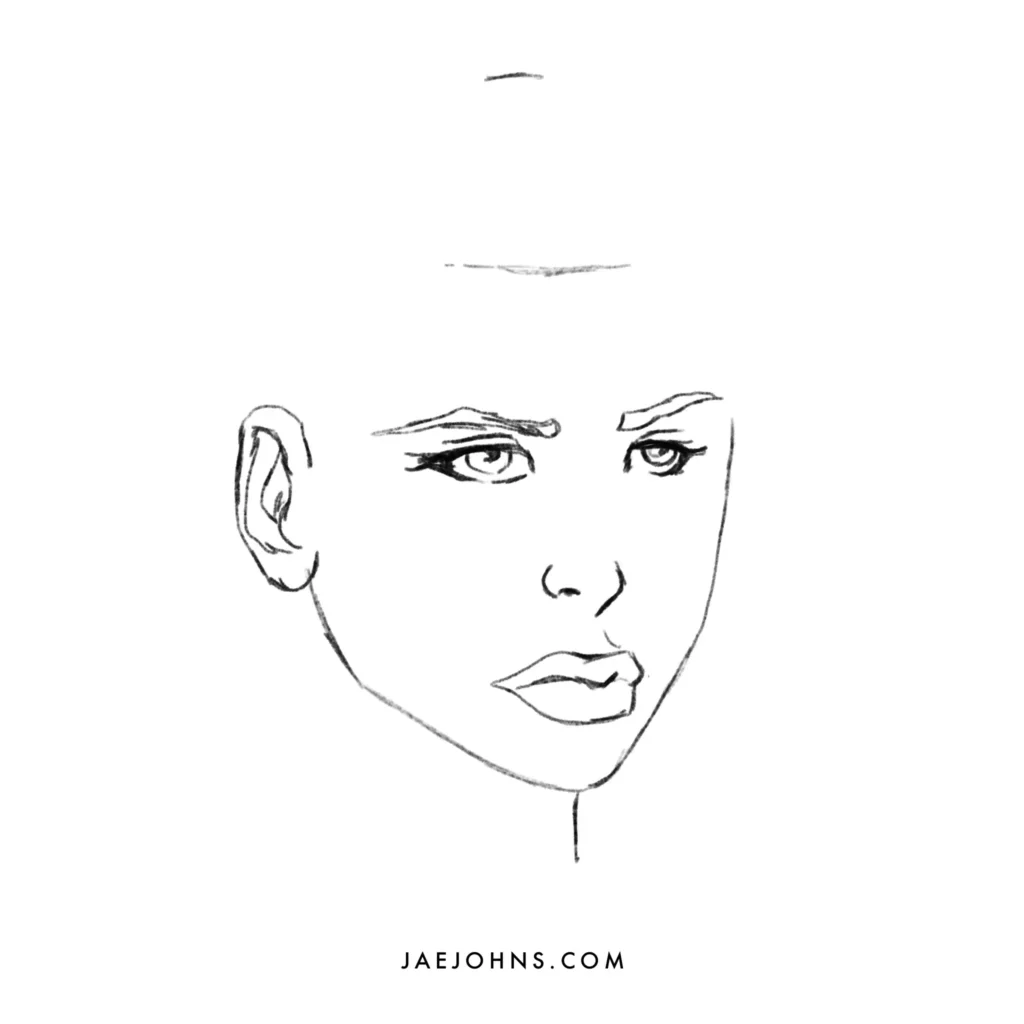
Once you’ve placed all the facial features, it’s time to use an eraser to remove the supporting lines.
You can ink the main features and erase the pencil lines beneath to do this, or simply trace the supporting lines more lightly than the finished lines as you draw.
Now is the time for details and carving out the realistic shape of each feature better.
For example, you can add curved, organic lines to each of the features, and better define each facial feature.
The lips and ears can be given small shadows to increase their depth.
Draw the groove above the mouth and below the nose.
You can also draw the neck and collar of a shirt.
Step 5 – Draw the Hair
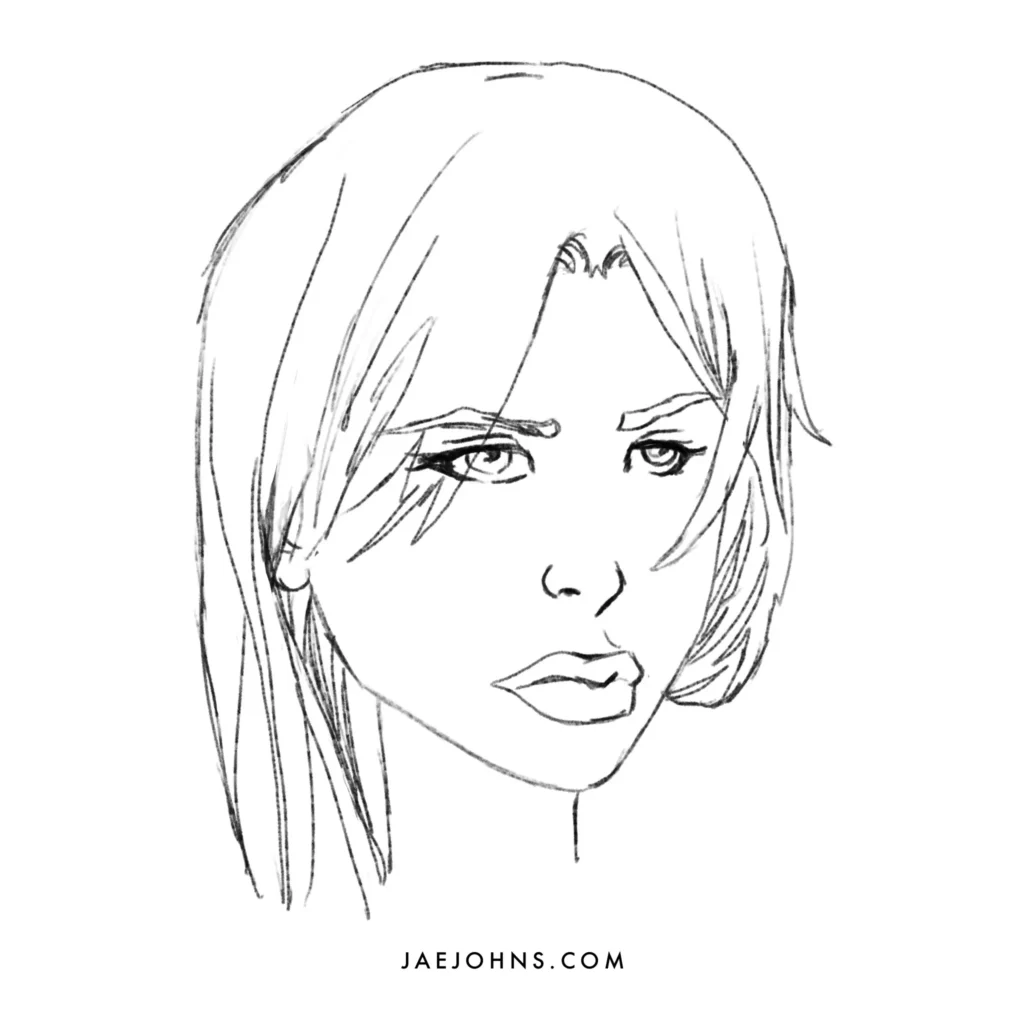
The hair volume should be drawn as coming out from the hairline organically.
Shorter hair will stick up directly, while longer and bushier hair will come out in volumes that from the scalp outwards.
The hairline can start as a dark space that grows out from a direction in space outwards.
Strands of hair and their exact flow is an art that needs to be studied and teased out on its own.
Hair growth, including facial features, acts differently at different stages, plus differently for the four different types of hair.
Step 6 – Light and Shadow
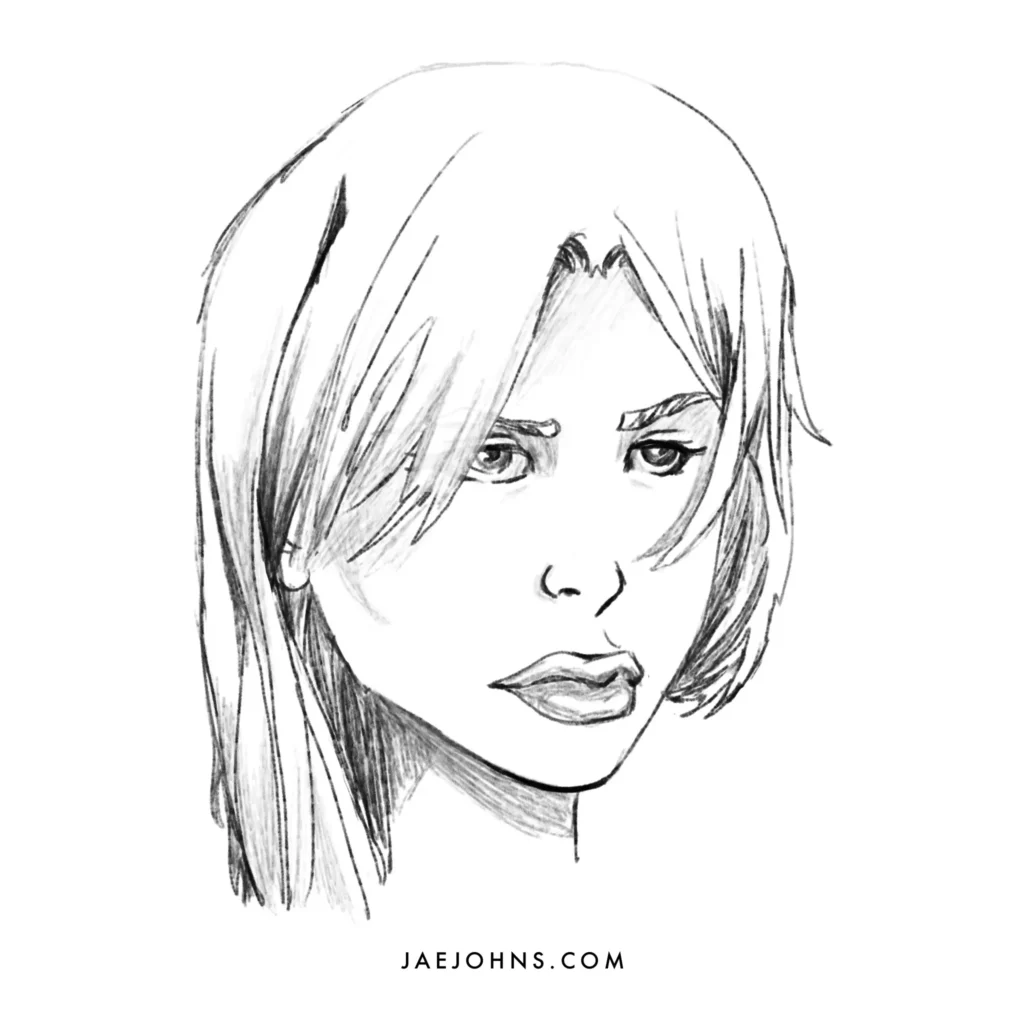
How bands of light and the behavior of light generally fall on the face can be shown with proper shading.
Even a bit of shading allows for the difference between a dark edge and a light edge to give a more three-dimensional view of the face.
The elements of shading the difficult features of the face are some of the hardest to get precisely correct.
Look for good instruction on shading to help you understand the light lines and how to capture them adequately.
Key features of the face will pop once you have a proper understanding of the concept of shading.
Differences in How to Draw Faces for Men and Women
General Differences Between Men and Women Faces

In general, when you’re learning how to draw men’s faces, they are longer and larger. However, this essential point doesn’t help draw them too much.
A good general rule of thumb is to draw males with more square shapes and females with rounder shapes.
Both men and women make intriguing subjects, so don’t neglect either of them.
Male Eyebrows and Female Eyebrows
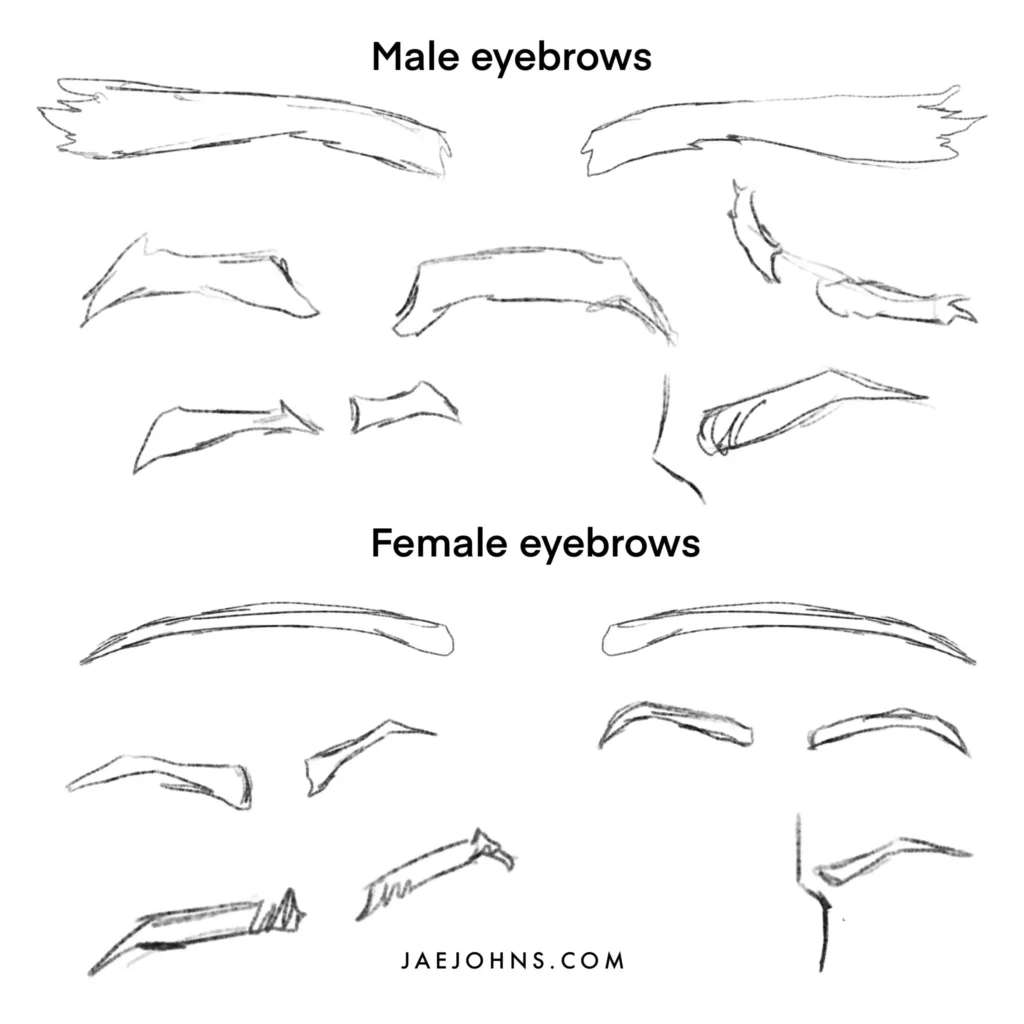
Men tend to have bushier, thicker eyebrows, whereas women tend to have thinner eyebrows.
Eyebrows can play a significant role as a gender indicator.
Some men have thin eyebrows, and some women have thick ones, but overall the trend is strong in the other direction.
Furthermore, men’s eyebrows tend to be more angular, coming to an abrupt stop at the three-quarter mark then trailing downwards.
Women’s eyebrows tend to wave slightly and have more of a general curve.
Male and Female Eyes
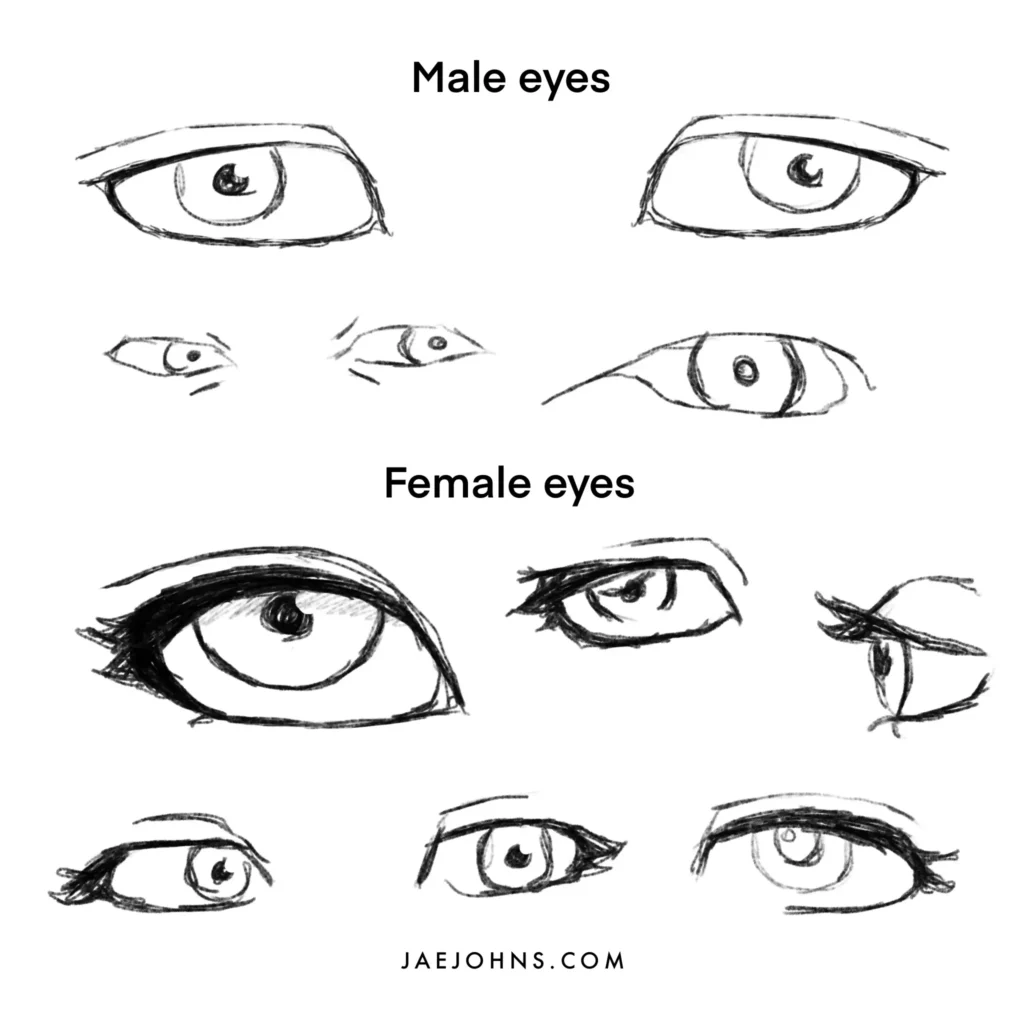
For female portrait drawings, eye shapes can be made more feminine by adding longer lashes that curl outwards.
This helps to make the eyes look bigger.
You can also make the eyelashes thicker, darker, or more compact to give the impression of wearing mascara.
The base shape of the feminine eye should be an oval.
For a male portrait, the lashes should be kept short or not at all.
This doesn’t work for a close-up shot, but they can be avoided to make the man appear more masculine for many other portraits.
The base shape of the male eye should be more rectangular.
Male and Female Nose
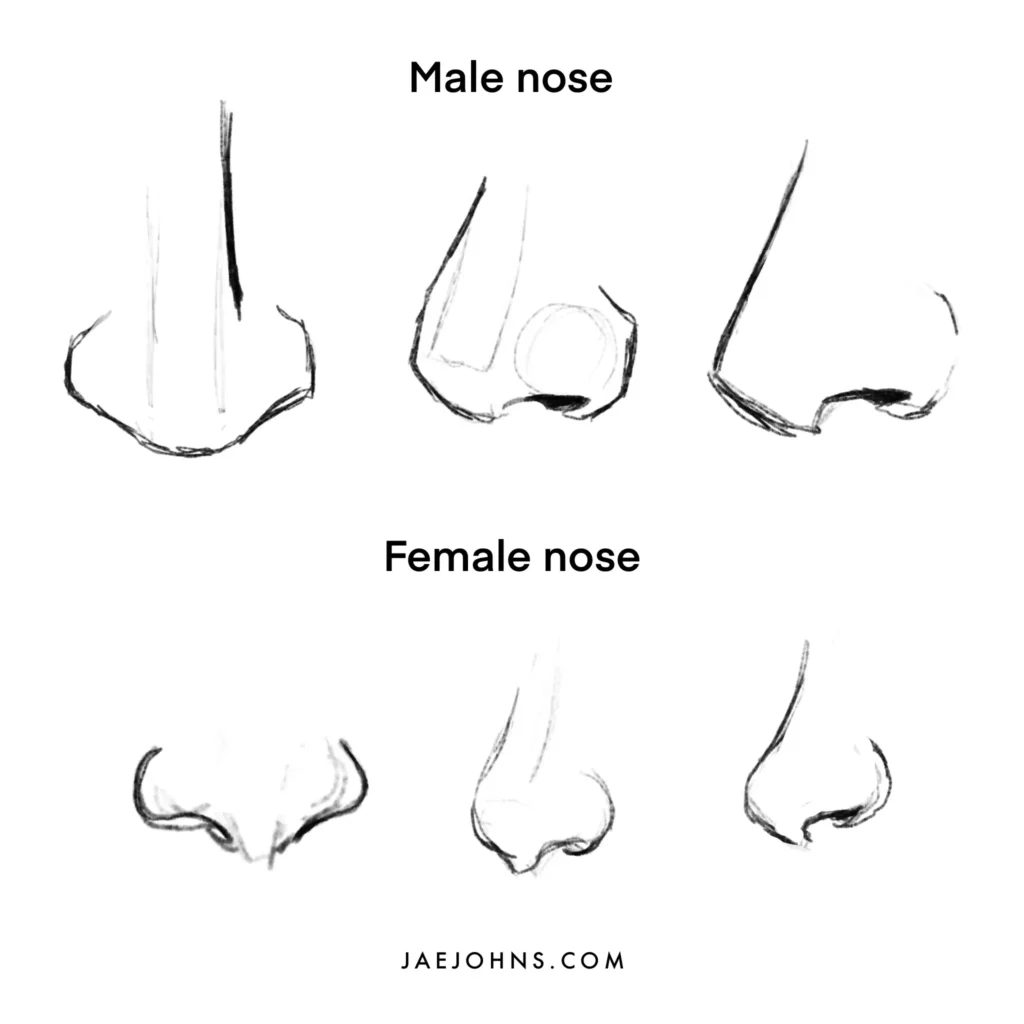
Feminine noses tend to be as minimal as possible.
The portrait does better if the focus is on the eyes and the lips.
There can still be some character to the nose, but generally speaking, the nose can be kept to a minimum in comparison to the other facial features.
The prominent nose features for women tend to be the tip and nostrils, minimizing the bridge.
Male noses can add a masculine touch to a portrait by adding angularity and sharp edges.
Look for square and rectangular shapes on the nose.
Male and Female Cheekbones
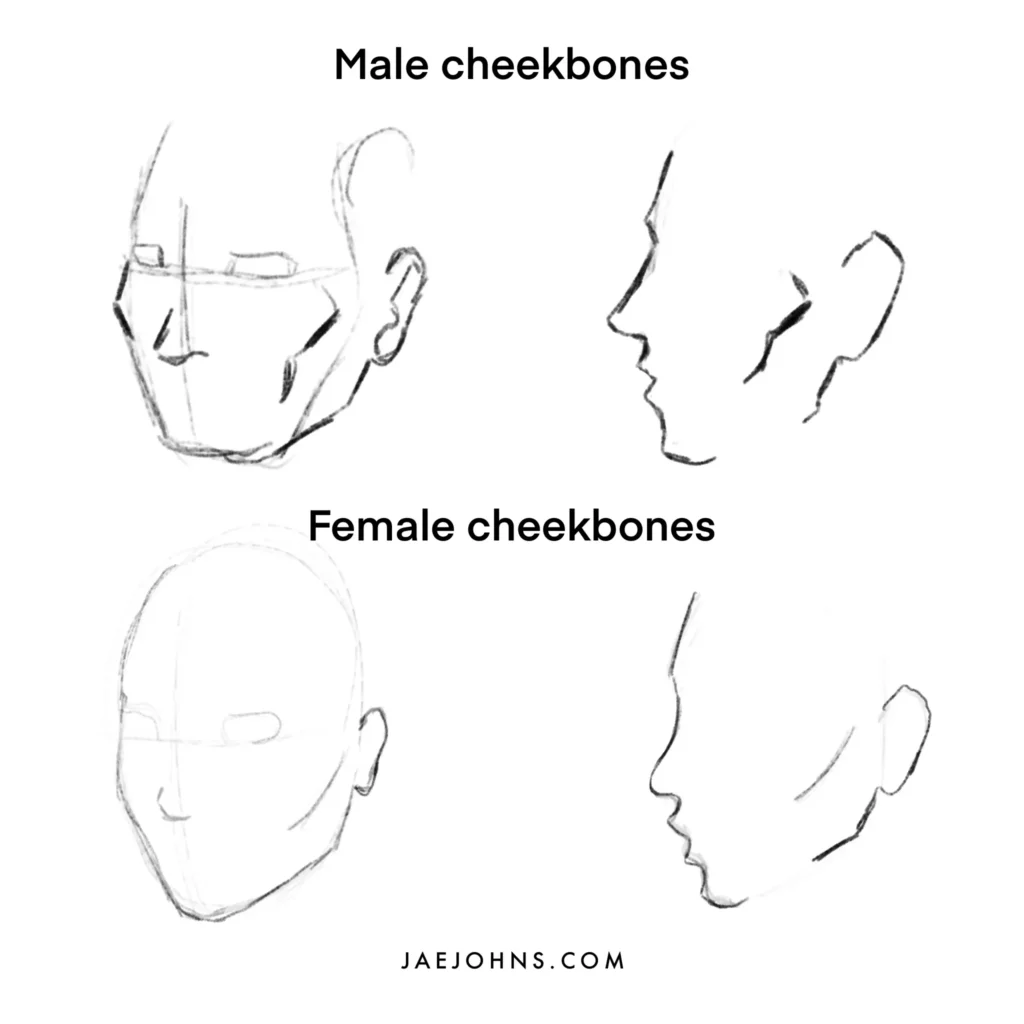
The primary way to show cheekbones is through the light and shadow regions of the cheek.
But, you can also add a very thin line to show where the cheekbone would be.
Shading can also be an essential aspect of carving out the cheekbones.
More than other features, the patterns of light on the face will make the cheeks visible.
The behavior of light shows gradations from light to dark.
For a man, you can draw the bottom edge of the cheekbone, allowing you to define the lower area of the face with a sharp cutoff.
Women are different in that you want to keep the cheeks looking rounded and softer.
So instead of giving a harsh cutoff, put detail into the top part underneath the eye.
Male and Female Mouth and Lips
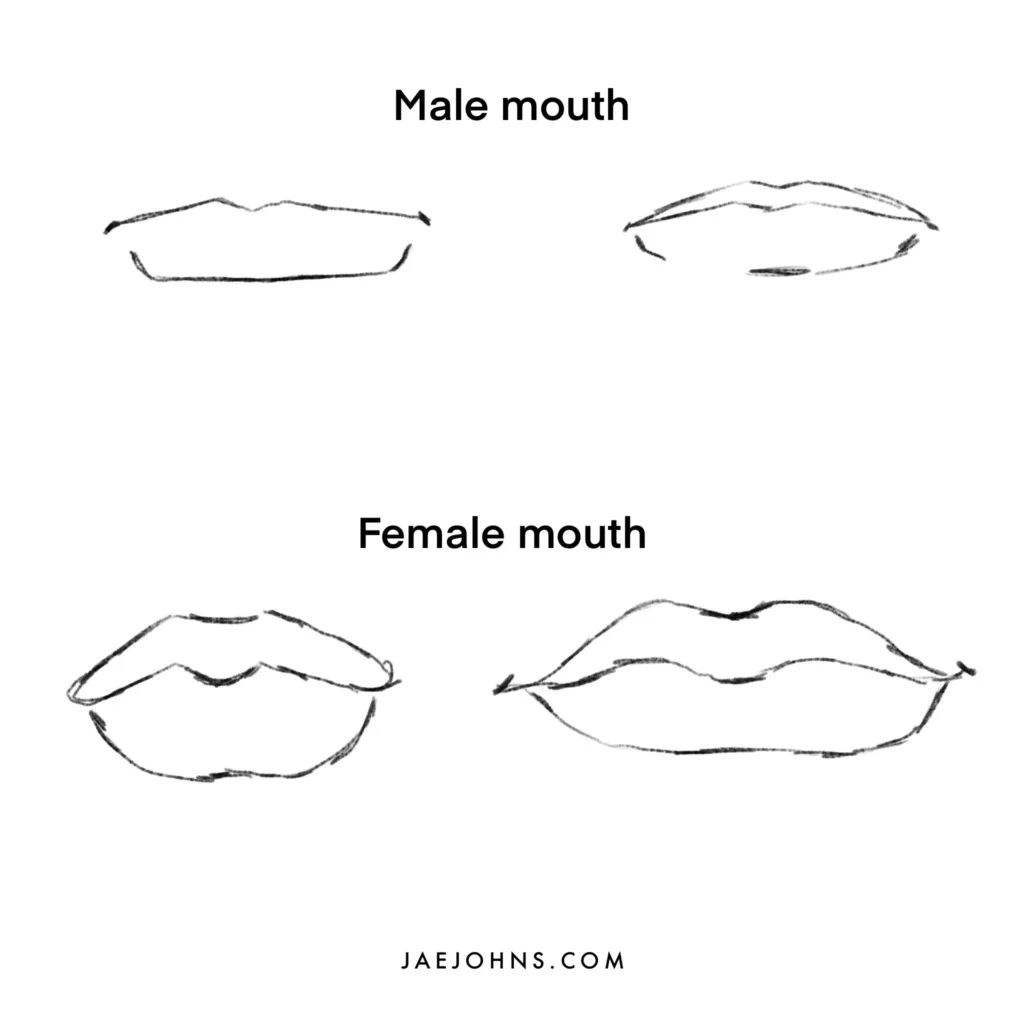
The mouth can differentiate male and female faces.
Sometimes, you can leave out the upper lip entirely with men to quickly give a more masculine look.
On the other hand, you can go with a skinny upper lip and a wider overall mouth if that is too unrealistic for you.
With female mouths, the opposite is true.
Accentuating the upper lip will immediately give a feminine impression.
Upper lip angles don’t matter much as long as the lip is present.
Regardless of the overall style of the lip, detailing the upper lip will help to give the portrait a more feminine air and works from a variety of angles.
Male and Female Jawline
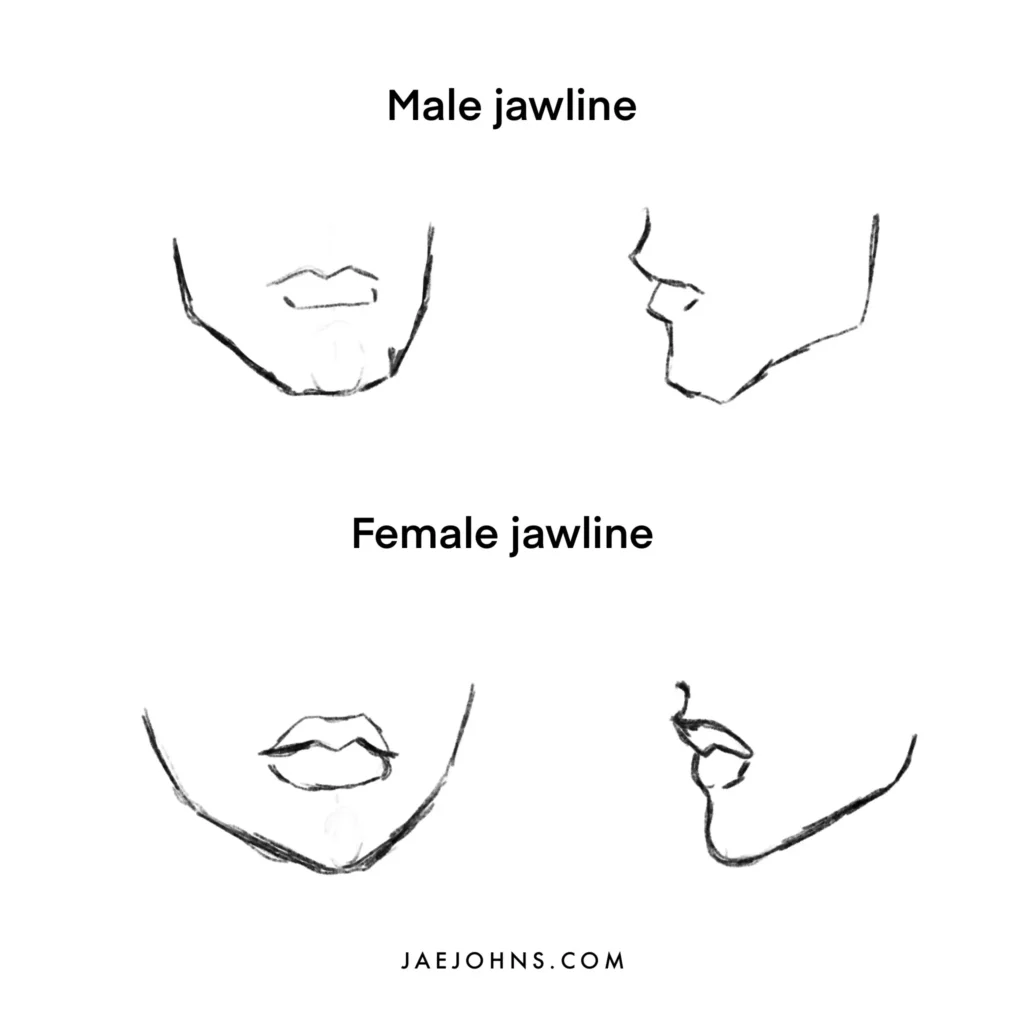
The jawline defines both the chin and the jaw of the portrait.
This follows the basic principles I’ve been saying.
A more angular, square jaw will look very masculine, whereas more rounded, soft curves will look very feminine.
For a masculine jaw, put a lot of focus and detail into the thick, sharp lines of the jawline and chin.
For the feminine jaw, drawing the least attention to the jawline and chine is best.
Male and Female Neck
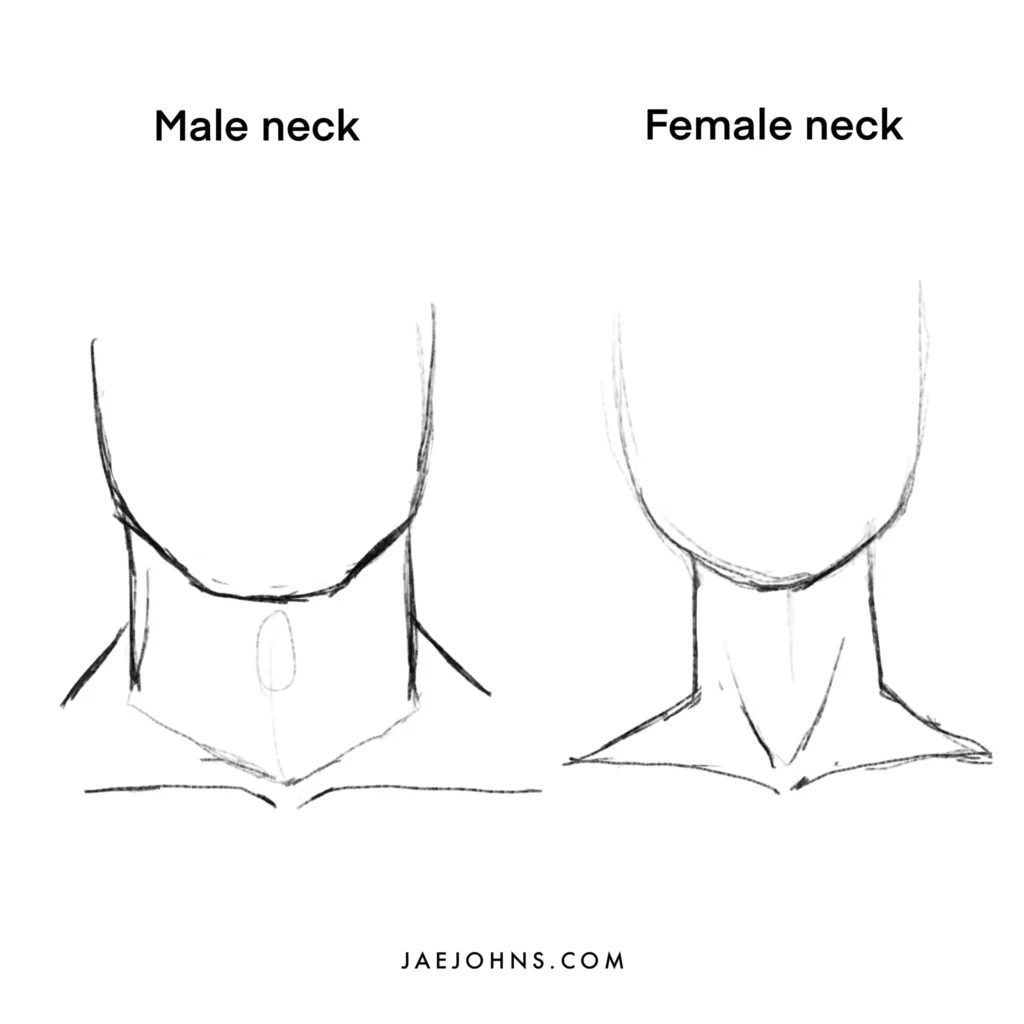
A quick and easy start to a men’s neck is the adam’s apple.
Even a tiny line to give it a shape can help.
On a broader note, thin, graceful necks tend to be more female, whereas thick, more muscular necks tend to lean male.
You can also consider skin tones at this stage, as the texture of skin for each gender tends to be slightly different.
For example, male skin is thicker, rougher, and darker, whereas women’s skin tends to be thinner, smoother, and more uniform in color.
Male and Female Hair

Facial hair is perhaps the easiest giveaway of a male-looking face.
Even just the shade of a five o ‘ clock shadow can do a lot.
However, a male featured face will stay masculine even with long hair and no facial hair, so the features can do a lot of work.
Similarly, feminine facial features will remain feminine even with short hair or a buzzcut.
The hairline can be pretty different too.
A man’s hairline tends to be further back, especially as he gets older.
This means their foreheads are more prominent.
The hairline on a woman is more rounded, with less of a widow’s peak.
Men tend to lose the hair above the temples first, giving their hairline a kind of heart shape.
And that’s it for differences to make a portrait look more male or female.
Conclusion
I hope this step by step approach helps you at drawing faces.
Drawing a face is all about proportions at first.
Getting the proper measurements between features and understanding those proportions at different angles is at the heart of all outstanding portraiture.
After that, it becomes a study of the details in the features of the face and learning how to create the shape of those features with the least detail possible, affirming the shape of the face.
Mastering these aspects of portraiture will do you well for the rest of your time as an artist.

